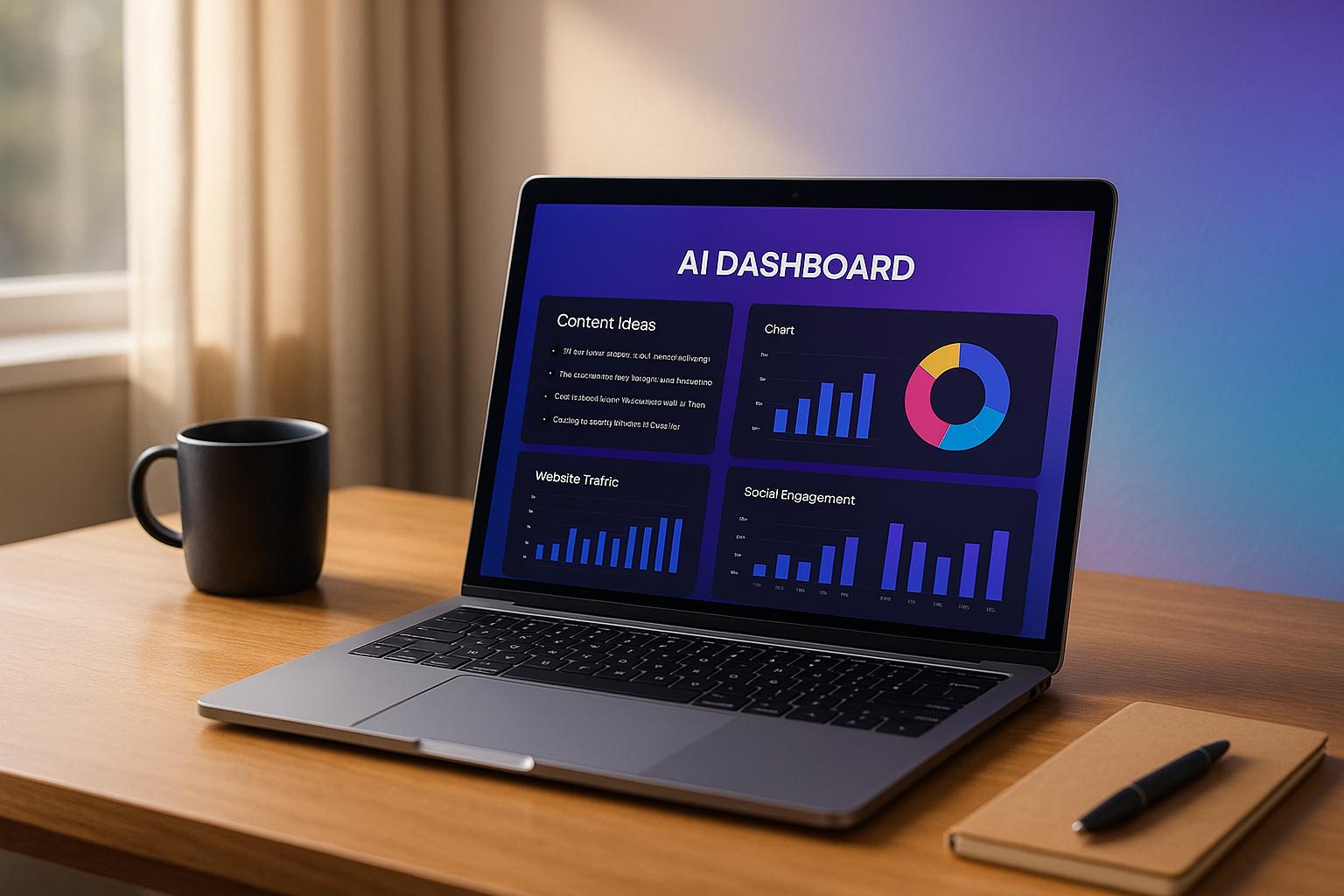Real-time data sync is transforming white-label AI marketing by instantly updating customer data, campaign metrics, and other critical information across platforms. This eliminates manual processes, improves customer experiences, and boosts marketing performance.
Key Benefits:
- Efficiency: Cuts manual lead entry by 55% and handles over 60,000 leads per month.
- Customer Experience: Reduces support response times by 80% and improves engagement.
- Marketing Optimization: Enables faster adjustments for better ROI, such as increasing add-to-cart rates from 3% to 20.15%.
Tools and Methods:
- Two-Way & Multi-Way Sync: Keeps data consistent across systems.
- Change Tracking: Ensures accuracy with features like version control and conflict detection.
- API Integrations: Connects with 3,500+ apps for seamless data flow.
Real-time sync not only saves time but also drives measurable results, such as a 28% increase in lead conversions and a 75% jump in e-commerce order value. By integrating AI, cloud systems, and IoT, businesses can scale efficiently while maintaining data accuracy and compliance.
Marketing Benefits of Real-Time Data Sync
Data Accuracy Across Platforms
Real-time data synchronization changes the game for marketing agencies by keeping data consistent across various tools and platforms. It ensures that customer details, campaign metrics, and engagement stats are always up to date, eliminating duplicate or outdated records. This reliable data helps create more tailored customer experiences.
Better Customer Interactions
With real-time data sync, marketing teams can provide timely and personalized customer experiences. For example, a dental clinic saw a 40% drop in missed appointments after adopting an AI-powered scheduling system with instant updates. This system ensures appointment details are updated across all channels, improving communication with patients.
"Perfect for SaaS marketing needs. Their product-led growth campaigns and technical content creation are outstanding. Reduced our client acquisition costs by 35% while increasing MRR growth by 225%. The multi-channel automation saves us countless hours."
– David Park, Growth Lead
The impact isn't limited to appointments. A logistics company cut call handling costs by 35% using automated delivery updates that keep customers informed in real time. Meanwhile, a real estate agency boosted lead conversions by 28% with AI agents that scheduled property tours using synced data.
Quick Marketing Adjustments
Real-time sync also enables marketing teams to adjust campaigns quickly. With access to real-time metrics, teams can make fast decisions that improve ROI. For instance, a cosmetics brand increased its add-to-cart rate from 3% to 20.15% by optimizing product recommendations and customer targeting in real time.
"Transformed our agency's capabilities overnight. The white label SEO and AI chatbot services integrated seamlessly with our existing stack. Implementation took just 6 weeks, and we saw ROI within 3 months. Their GDPR compliance and technical support are outstanding. Particularly impressed with their custom reporting dashboard - clients love it. Increased our revenue by 245% in 12 months."
– Sarah Chen, CEO
| Performance Metric | Improvement |
|---|---|
| Lead Processing Capacity | 60,000+ monthly |
| Support Response Time | 80% reduction |
| Lead Entry Efficiency | 55% reduction |
| Campaign ROI Timeline | 3 months |
AWS re:Invent 2023 - Break down data silos using real-time ...
Data Sync Methods and Tools
Various sync methods and tools play a key role in ensuring marketing data stays accurate and up-to-date, driving efficiencies in real-time operations.
Two-Way and Multi-Way Sync
Modern white-label AI platforms use advanced synchronization techniques to keep marketing data aligned across different tools. Two-way sync ensures that any updates made in one platform automatically reflect in another. Meanwhile, multi-way sync goes a step further by coordinating data across multiple systems at once. For example, agencies using White Label AI Solutions' lead generation tools with multi-way sync can maintain accurate data across their entire marketing stack, including CRM, email marketing, and campaign management tools.
Change Tracking Systems
Reliable change tracking systems are essential for maintaining consistent data and avoiding conflicts. These systems ensure smooth integration and accurate reporting by incorporating features such as:
| Tracking Component | Purpose |
|---|---|
| Timestamp Logging | Records the exact time of data changes |
| Version Control | Keeps a history of all modifications |
| Conflict Detection | Identifies and resolves data inconsistencies |
| Audit Trail | Tracks who made changes and when |
White Label AI Solutions uses these systems to streamline lead processing. Their automated lead qualification and CRM synchronization have reduced support response times by 80%.
API Connection Methods
APIs are the backbone of data sharing between marketing platforms. White Label AI Solutions employs a robust API framework that supports both native integrations and custom connections. Through Zapier, the platform links with over 3,500 apps, while also offering tailored setups for specific industries. Many agencies take a hybrid approach, combining native integrations with automated workflows to enhance lead management and customer support. For instance, White Label AI Solutions integrates AI chatbots with CRM systems, enabling real-time lead qualification, appointment scheduling, and consistent data synchronization across channels. This ensures seamless campaign updates and improved customer engagement, amplifying the marketing benefits outlined earlier.
Common Problems and Fixes
Real-time data synchronization can be tricky, but there are practical ways to address the challenges.
Older System Integration
Older systems often struggle to work with modern real-time sync tools. For instance, marketing teams may face hurdles when trying to link outdated CRM systems or email platforms with newer AI-driven tools. Middleware solutions can help bridge these gaps. One example showed how a cookieless tracking solution addressed privacy concerns while still achieving 98% data accuracy. This approach not only modernizes older systems but also supports better data privacy practices.
Data Privacy Requirements
Real-time syncing creates unique challenges when it comes to protecting data. Ensuring privacy while meeting regulations like GDPR and CCPA is a balancing act. Here’s how organizations tackle it:
| Compliance Component | Implementation Strategy |
|---|---|
| Data Encryption | Use AES-256 and TLS 1.2 protocols |
| Access Control | Role-based permissions with audit trails |
| Consent Management | Automated tracking and updates |
| Data Residency | Store data in region-specific locations |
"Best-in-class GDPR compliance and automation. Onboarding was smooth with dedicated technical support. Their cookieless tracking solution solved our privacy concerns while maintaining 98% data accuracy. The automated consent management is brilliant. Scaled our agency across the DACH region without hiring additional staff." - Marcus Weber, Operations Director
Striking the right balance between compliance and cost efficiency often leads to smarter, budget-conscious solutions.
Budget-Friendly Setup
A cost-effective setup is key to making real-time synchronization sustainable. Many organizations have achieved impressive savings with thoughtful implementation.
For instance, a telehealth provider managed to cut patient wait times by 50%, while a logistics company reduced call handling costs by 35% through automated delivery updates. These examples highlight how smart strategies can lead to both operational efficiency and cost savings.
Marketing Results with Real-Time Sync
Real-time sync isn't just a technical upgrade - it's delivering measurable marketing success across various industries.
Targeted Marketing
With real-time sync, businesses can create highly personalized campaigns with pinpoint accuracy. For example, TechWave, based in California, cut client acquisition costs by 35% while boosting monthly recurring revenue by 225% through precise, product-led growth campaigns. This approach not only trims costs but also improves how quickly campaigns can adapt to changing needs.
ServCorp Digital, a Sydney-based company, showed how synchronized data can elevate B2B marketing efforts:
| Metric | Improvement | Timeframe |
|---|---|---|
| Lead Quality | 85% increase | 6 months |
| Client Retention | 92% rate | Continuous |
Live Campaign Updates
Real-time updates allow teams to adjust marketing strategies on the fly, making campaigns more agile and effective. Agencies can respond to market changes immediately, with adjustments typically completed in 6 weeks and ROI seen within 3 months.
Beyond marketing, this capability improves overall operations. For instance, automated response systems reduce support delays, leading to better customer engagement and faster resolutions.
Success Stories
Here are two examples that highlight the impact of real-time sync:
-
Real Estate Industry
A real estate agency used AI-powered scheduling for property tours, which increased lead conversions by 28%. This was made possible by real-time updates on property availability. -
E-commerce Growth
DigitalCraft in London revamped their marketing operations by synchronizing data across platforms. Their headless commerce setup and cross-channel attribution efforts resulted in a 75% jump in average order value.
These examples show how real-time data sync can drive both marketing and operational success, allowing agencies to deliver clear, measurable results while staying efficient.
What's Next for Data Sync
AI and ML Updates
Machine learning is revolutionizing real-time data synchronization. Recent testing shows that advanced AI systems can handle up to 10,000 simultaneous chats with latency under 2 seconds. This ensures scalability without sacrificing performance.
Deep learning is also reshaping content personalization. These systems analyze customer interactions in real time, continuously improving their precision and effectiveness. For instance, AI-driven behavioral analysis helps marketing teams better understand customer sentiment, enabling automated adjustments to engagement strategies.
As personalization tools become more refined, adopting robust cloud solutions ensures they can perform efficiently, even at scale.
Cloud System Growth
Cloud infrastructure is evolving to keep up with increasing data demands. Take Saba Clinics, for example - they process over 175,000 monthly WhatsApp feedback requests seamlessly using cloud-based systems.
Modern cloud architectures come with key benefits:
| Feature | Benefit | Impact |
|---|---|---|
| Instant Scalability | Handles seasonal demand spikes | Ensures smooth performance during peak times |
| Dedicated Environments | Enhances data security | Meets compliance requirements |
| Hybrid Storage | Optimizes media handling | Lowers storage costs |
IoT Data Integration
The Internet of Things (IoT) is creating new opportunities for data collection and analysis. AI-powered systems can now process data from multiple IoT sources simultaneously, providing deeper insights into customer behavior.
Practical applications highlight the potential:
| Application | Results | Timeframe |
|---|---|---|
| Lead Generation | 55% reduction in manual entry | Immediate |
| Support Automation | 80% reduction in delays | Ongoing |
| Customer Engagement | 800% ROI on renewals | Annual |
The combination of AI, cloud systems, and IoT is shaping the future of data synchronization. Companies leveraging these technologies are seeing improved efficiency and customer satisfaction. For example, businesses using AI-powered self-service support report fewer tickets while maintaining high-quality service.
Conclusion
Main Points
Real-time data synchronization plays a key role in white-label AI marketing. By using AI-driven systems and syncing data instantly, companies achieve measurable outcomes. This includes streamlining operations, cutting down manual lead entry, and reducing support delays significantly.
Beyond operational improvements, this approach boosts customer engagement and drives revenue growth. For example, agencies managing 50-client portfolios have reported a 214% ROI within a year.
Here’s a snapshot of the key benefits:
| Benefit | Impact | Timeframe |
|---|---|---|
| Lead Generation | Over 60,000 leads/month | Ongoing |
| Support Efficiency | 80% delay reduction | Immediate |
| Client Retention | 92% with analytics | Annual |
| Gross Margins | 83% at scale | Sustained |
Next Steps
To take advantage of these benefits, consider these steps for integrating real-time synchronization into your strategy:
-
Start with Core Integration
Bundle AI chatbots with CRM audits to see immediate efficiency improvements. This creates a solid base for adding advanced features later. -
Optimize Resource Allocation
Use hybrid AI models to improve cost efficiency. Data shows that agencies can achieve 4-7x ROI by bundling services strategically. -
Monitor and Refine
Conduct weekly performance reviews of your AI systems. For instance, Stammer AI’s March 2025 Leads 2.0 release cut manual data entry by 40% during beta testing, highlighting the value of regular monitoring.
"Stammer.ai has solidified its position as a leading white-label AI platform for digital marketing agencies and enterprises seeking to deploy branded AI solutions."


